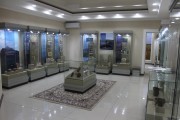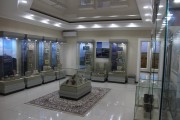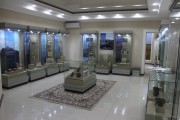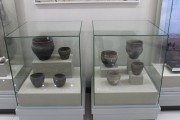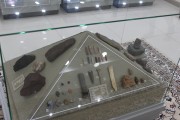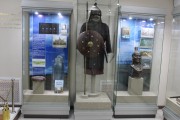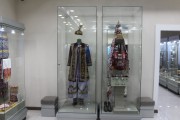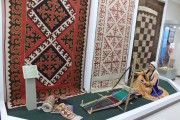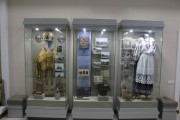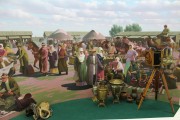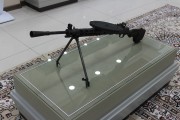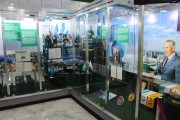Exposition
Hall «Nature»
In the hall of "Nature" materials are presented by sections: reliev, soil, climate, geology, scientists researchers, flora and fauna. The exposition is designed in accordance with the landscape method of display using ecosystems.
In diorama " Forest dwellers" are presented such animals as: a wolf, a fox, a badger, a roe, a hedgehog.
The important part of exposition have materials on national state park "Kokshetau" , "Burabay", "Buiratau", "Korgalzhyn state nature reserve" , "Nature's protection"(animals and plants demanding protection, poaching, environmental pollution ) , natural monuments.Collection of minerals and rocks are of great interest. The hall is equipped with multimedia installations, which allow to show not only photos, but short video clips too, allowing to see animals and birds in habitat, to hear their voices and sounds of environment.
Hall of «Natural history». Paleontology.
Hall presents stages of the development of life on Earth, some materials about flora and fauna in ancient times. It's widely represented «Anthropogen» section with a profile reconstruction of mammoth, bone remains of such animals as: mammoth, wooly rhinoceros, bull-tur, bison, big-horned deer discovered in different times on the territory of region. Demonstration of popular science films about ancient animals is provided for visitors.
Hall "Great steppe civilization". Archeology.
The hall presents a history of our region, beginning with dtone age up to early iron age. Main exhibits are the collections of archeologocal expeditions , carried out in different times on the territiry of Akmola and North Kazakstan regions.
Stone age is presented by 3 main stages of evolution of ancient man : Paleolithic, Mesolithic, Neolithic. Paleolithic site is reflected in diorama "Aktas" .- Eneolithic is a transition period between Neolithic and Bronze age, when taming of wild horses had finished in steppe of Kazakhstan and for the first time on planet , in IV c BC the horse was domesticated and horse breeding was born. Visitors have the unique opportunity to watch how the women of Bronze Age dressed. The finds, discovered in mounds of early iron age demonstrate high and distinctive culture of Saka tribes and the development of social society.
Hall "Great steppe civilization" Middle Ages.
In VI-X c AD Akmola region was part of Turkic, Western Turkic, Korluk, Kimak kaganates. It is well known , that the Great steppe gave the world horse breeding and equestrian culture.
You see the foal on the background of diorama with picturesgue image of the endless steppe. And armor and armament of Kazakh warrior are presented. The collection of medieval coins of Kazakhstan (VII -second half of XIXc) and chinese bronze mirror of the Tang dynasty (VII-IXc) with the image of lions are unique.
Hall "Great steppe civilization". Ethnography.
Kazakh nation is a great representative of Nomadic civilization. Culture of Akmola region is an encyclopedia of life, customs and traditios , which includes features of culture of previuos times. It's versatility and originality reflected in characteristics of dwellinh, clothing, in ideas about environment, religion,folklore and art. The halls "Kystau" and " Ethnography" introduce to the peculiarities of life of ethnic group, economic culture and traditions, to the best examples of ethnographic collections. The hall " Kystau " includes following sections: "Features of economic and cultural structure" , "Agriculture", "Hunting". "Interior of winter dwelling of Kazakhs " installation shows, that along with the yurt, part of kazaks , roamed with cattle, had constant wunter site-kystak, kystau with household buildings. In XIX c kystau for kazaks was the basis and elementary land unit. Sections of the hall "Ethnography" present original culture with famous akyns and masters of oral art such as : Birzhan sal, Akan sery, Ukily Ybyrai, Baluan Sholak, Emanzhusup , Koken Shakeyev, Karim Iliyasov, Ementayev, Zhumabay Esekeev, Iran Taskara, Alimzhanov , and others. Among the well-known kazakh theologians and educators are Nauan Hazret, Shaimerden Kosshigulov, Momakan Aliev, etc. Exposition presents the elements of yurt's interior , unique samples of felt production, weaving and carpet weaving, embroidery, jewelry art, traditional clothing and folk music instruments.
Hall "Great steppe civilization". Abylai Khan.
Museum exposition of the hall "Abylai Khan" is of special interest. Kokshetau region became widely known in Kazakhstan and abroad in the era of one of the most auth
Hall "History of Akmola region in XIX c"
Social -economic and political life of the region in XIX c.is reflected here : formation of external districts , resettlement movement. A history of Kokchetav and Akmolinsk.
You can see the interiоr a town house in the end of XIX c. The items , that were relevant on the counters of the period of XIX c are presented against the background of fair's panorama.
Hall "History of Akmola region in XX c"
The hall " History of Akmola region in XX c " is devoted to the most important historical events of XX c , full of bright, sometimes dramatical events , reflected in the history of Akmola region : the First World War, the national liberation uprising of 1916, national movement and creation of the government "Alash Orda ", the October Revolution of 1917 and Civil war of 1918 - 1920 , hungerand political repressions of 30th, civilization and industrialization , thr Great Patriotic War , the development of virgin and fallow lands, perestroika, participation in the Afghan war. The most important event at the end of the XX centure became the proclamation of state Independence of the Republic of Kasakhstan.
Hall "Elbasy zhane Tauelcisdik"
Central place in the hall "Elbasy zhane Tauelcisdik" take place state symbols of republic of Kazakhstan , Constitution of Kazakhstan, Constitutional Laws of fateful significance in history of state building of independent Kazakhstan. For visitors of museum are widely represented Elbasy's life, archival documents , reflecting the history ofpersonality's formation, his way of life from single worker to political statesman, the Leader of Nation, recognized by the world community ( photos from personal family archive, his shezhire, models of personal items and valuable gifts, etc ).
These museum exhibits have historical value and play the great role youth education in spirit of new kazakhstan patriotism, in striving for renewal and formation of new values while maintaining the national cultural code and identity.
A special place in exposition of the hall is given to the capital of Great steppe Nur-Sultan city as the symbol of Independence and Triumph of idea of the head of the state , spiritual modernization of Nation, the driver of the country's successful development.
The capital is presented as political, economic and cultural metropolis, the sacred centre of Kazakhstan.
Creation date: 12.02.2017 16:47
Update date: 03.07.2020 18:50














